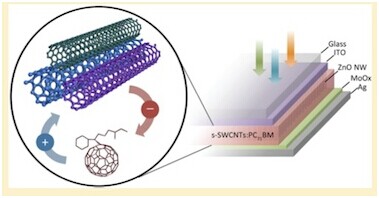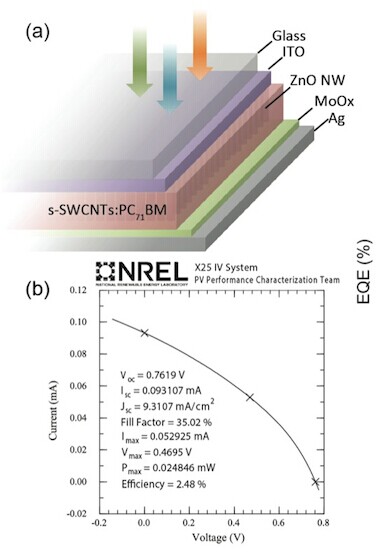A new solar cell made from carbon nanotubes (CNTs) that is nearly two times better at converting sunlight into power than the best previous such cells has been unveiled by a team of researchers in the US. The National Renewable Energy Laboratory (NREL) has already independently certified the performance of the device – a first for a CNT-based solar cell.
Thin-film photovoltaic materials are better than conventional solar-cell materials, such as silicon, in that they are cheaper to make, are lighter and more flexible. They work by absorbing photons from sunlight and converting these into electron-hole pairs (or excitons). To generate electric current, an electron and hole must then be separated in the brief space of time that it takes before the two particles come back together and are reabsorbed into the material. In solar cells, the exciton must quickly travel to another layer in the device (where the charge separation will occur), for the best light absorption efficiencies.
Although single-walled carbon nanotubes are ideal for TFPVs because they absorb light over a wide range of wavelengths from the visible to the near-infrared and possess charge carriers (electrons and holes) that move quickly, most TFPVs containing SWCNTs so far have suffered from limited current and voltage, and thus poor power conversion efficiencies.
Polychiral CNTs absorb over broader solar spectrum range
Now, a team led by Mark Hersam of Northwestern University and Shenqiang Ren at the University of Kansas along with colleagues at the Massachusetts Institute of Technology, has designed a new type of solar cell containing polychiral SWCNTs and fullerenes that maximizes the amount of photocurrent produced by absorbing a broader range of solar spectrum wavelengths. In particular, the cells significantly absorb in the near-infrared portion – a range that is currently inaccessible to many leading TFPV technologies, says Hersam.
A SWCNT is a sheet of carbon just one atom thick that has been rolled up into a tube with a diameter of about 1 nm. The atoms in the sheet are arranged in a hexagonal lattice and the relative orientation of the lattice to the axis of the tube is its chirality. “Previous CNT solar cells were mainly made from single-chirality CNTs, whereas our solar cells make use of tubes that are polychiral (that is, they possess multiple chiralities),” explains Hersam. “By using these multiple chiralities, our CNT solar cells absorb over a wider portion of the solar spectrum, which leads to higher currents and efficiencies,” he tells nanotechweb.org.
High voltage and high current = record-high PCEs
The researchers say that they also maximized the photovoltage produced by their solar cells by controlling the interface between the active, photovoltaic layer and the underlying hole-transport layer. This interface layer allows photogenerated electrons and holes to meet and efficiently recombine.
The combination of high current and high voltage produced in our inverted device structure is ultimately responsible for the record-high PCEs we observed, adds Hersam.

The devices could reignite interest in all-carbon solar cells, a research area that has been rather neglected in recent years. The fact that the new cells absorb over a broad range of light wavelengths, including in the near-infrared, means that they could especially be useful as the active elements in tandem or multijunction devices. As their name suggests, these cells contain two or more junctions (rather than just one), each of which absorb light of different wavelengths from the Sun. For example, the junctions at the front of the cell can be made of a wider bandgap material that harvests high-energy photons while more abundant lower-energy photons can be collected by a smaller-bandgap material situated at the back of the cell. They perform better than their single-junction counterparts with power conversion efficiencies of around 42% compared with just over 30%.
The team says that it is now busy trying to further improve the PCE of its CNT-based solar cells. “We also intend to introduce additional materials, apart from fullerenes into our future cell designs that complement the properties of CNTs,” says Hersam

